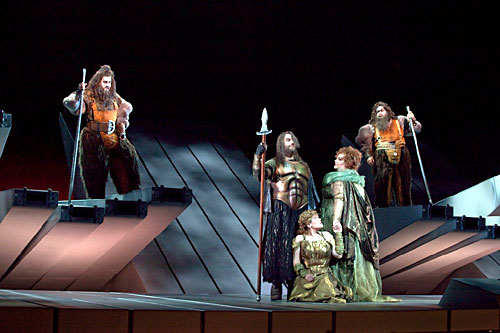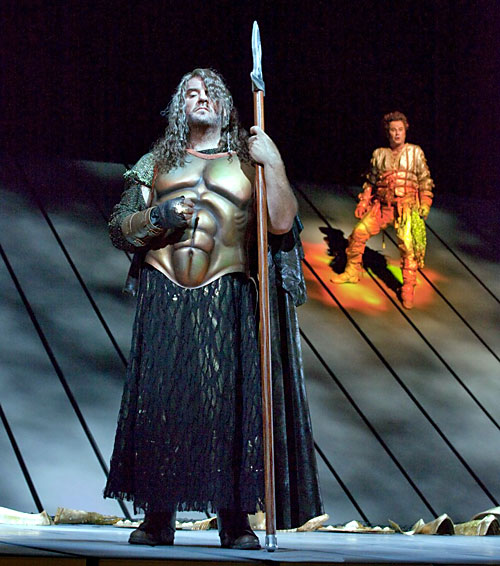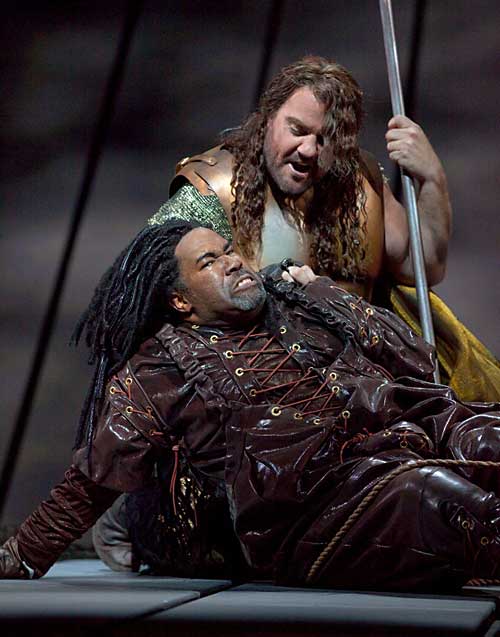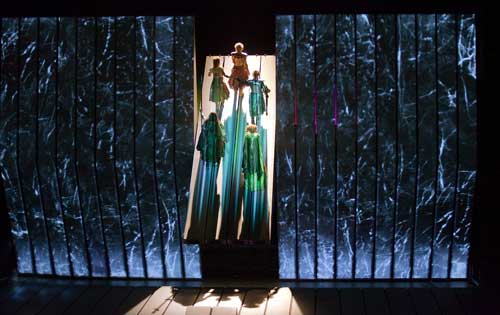|
When the Met launched its new Ring Cycle with Rheingold (the Prologue) last month, the technical fiasco of the final scene made headlines. The problem had been fixed, however, by the time the Met Live In HD performance was played in cinemas around the world: Wagner's Gods were, after all, walking over the rainbow bridge to Walhall, Valhalla. It must have been a strange irony to see them literally stranded, unable to reach the fortress that was supposed to keep them safe from mishaps of this sort. That the gods can get stranded is of course one of the interesting contradictions of Der Ring des Nibelungen that leaves no doubt about their all too human nature — their investment in gold and power politics, in bartering away women, tricking and cheating and trying hard not to get caught. The fascinating questions of who gets away with what, who will ultimately possess the ring of power and pay for it with the loss of love or life, makes Wagner's grand Ring cycle such an enduring favorite, an operatic evergreen since its opening in Bayreuth, in 1876.
In addition to the archetypal themes, the music of the Ring is a 16-hour wallop with innumerable ecstasies, and the theatrical challenges of staging the monster seem irresistible. Every opera house of standing has to have its own Ring, that is, a new one every decade or so. As long as Wagner's own son, Wieland Wagner, reigned over Bayreuth, everyone tried to imitate his brilliantly abstract, avant garde stagings. No more winged helmets and stuffy 19th century realistic stage sets. Pure light dramaturgy accompanied pure, motionless singing pouring from the likes of Birgit Nielson, Kirsten Flagstad, Wolfgang Windgassen, Moritz Melchior... The era of gigantic voices floating and roaring through light ended in 1976, when brother Wolfgang invited French theater genius Patrice Chéreau and musical maverick Pierre Boulez to celebrate the Bayreuth centenary with the first truly modernist approach to the Ring. It was a decision that changed the operatic landscape. Chéreau's focus on the psychological, political, historical relevance of Wagner's magnum opus, based on movie-style acting and stunning stage technology, opened the door to the Ring "fever" we have seen ever since.
Seattle started the trend in the States with its naturalistic, nordic-mythical Ring, ritually performed every summer; Los Angeles Opera under Placido Domingo recently had its sci-fi Ring, San Francisco re-launched last fall with Francesca Zambello's all-American Ring (to be completed next summer, see Scene4, August 2010), and the Met now pulls up in the race with a super-tech Ring, conducted by master James Levine and directed by Canadian experimental theater maven Robert Lepage. Lepage is known for brilliant shows (like his 2001 Far Side of the Moon) and also spectacular duds. His last Met adventure was a multimedia La Damnation de Faust by Berlioz with a zillion kaleidoscopic mini-scenes — a poorly acted, empty extravaganza, leaving the impression that for Lepage it can be enough to fill the stage with a backdrop of techno-visual eye-candy, while staying perfectly disconnected from the operatic work itself. With Rheingold, his staging places the Ring at an interesting, if precarious edge of extreme technology that is futuristic while it also pays tribute to the Ring's archaic story and refers back to Wieland Wagner's static concentration on singing.
 |
The set design is so spectacular that it is impossible not to be excited while it's also possible to wonder if it serves an almost self-sufficient function. The "machine," as the Met technicians call the thing, fills the whole stage with a kind of metal-slot assemblage that can twist itself into any shape in a second, flatten vertically into a projection wall, or lie down horizontally as an elegantly twisting and curving walkway. The slots can split and open up to create holes and promontories, sneak forward and back as if alive, rise into steeply raked floor planes that allow the singers to arrive on top and zip down, head first, like kids on a playground slide, only to pop up again stage-front, in a holding-ditch. To get back up on the steep rise is a bit harder and slower, and even just keeping hold somewhere in the middle of the slant is a challenge if you are an opera singer and have to belt across a huge Wagnerian orchestra at the same time.
 |
I couldn't help but feel the anguish of the Gods having such unsure tread in their proud realm above the clouds. Perhaps there is symbolic meaning here. But if so, what sense does it make that the fire god Loge, whose sly flexibility must save the Gods in Rheingold, is the most challenged and stymied of them all? No slippery wit is brought out in any of tenor Richard Croft's movements or singing, no Mephistophelian quick-silver irony in his body language or in his lovely, but all-too lyrical voice. He is oddly bandaged or bundled up; his hair stands up (to evoke flames?) and his gloved hands alight to small effect: like a twin of Peter Sellers holding glow-balls, all the singer's energies seem focused on his foot-hold. The other Gods get away with static nobility, as perhaps befits their status. Should one complain? Every role is superbly sung, especially the two arch-enemies, Bryn Terfel's Wotan and Eric Owens' Alberich, but poor Loge, got booed. Not without reason, alas. He should be a high point in the suspense story of Rheingold, but he came to symbolize the frustration with the fact that the real star, the main role, was Lepage's stage, and the director didn't have either enough interest left in directing his operatic actors or enough time to even get there. After all, the entire stage floor of the Met had to be reinforced to support the "machine" and that contraption was a tricky beast, as the opening night demonstrated.
"Do anything but make me speechless with awe!", Loge says in his attempt to trick Alberich (the gnome of the underworld who fashioned the ring in order to wrest power from the Gods): Alberich turns himself into a giant snake, and the Met stage set turns into a gigantic twisting and turning monster, while Wotan laughs it off.
Were we speechless?
I imagine that the sheer monumental size of the "Machine" filling the Met stage was more awe-inspiring in reality than on the screen. Let's take the Rhine Maidens, daughters of the Ur-river Rhine, symbol of the origin of life. They float nicely for a moment in front of the massive blue wall of an abstracted down-pour of the river, their shadows looking quite like mermaids. But they quickly settle on top of the wall where they loll in place, while projected grayish bubbles or pebbles seem to be rolling down from beneath them when they move or sing. The water wall is impressive, the Maidens, gorgeous though they are, with clarion voices, could do way more to stir up the water and the audience as well. Where is the Cirque du Soleil when one needs it? Or, for an unfair comparison, Karajan's 1978 Salzburg studio production that used lip-syncing, half-naked dancers in such elaborate, fishlike flight to make you speechless indeed?
The steep water wall of Lepage doesn't leave much chance or grip for Alberich to chase after his beauties. So there is some unfulfilled promise here, especially when the rising sunlight brings up only a faint golden projection shimmer on the grey wall – hardly more than a glimpse, a weak allusion to the powerful gold of the Rhine — and Alberich finally makes away with a little clump of the metal – just enough to forge his ring and allow a few mistakes in the process. Where is the visual fanfare? (How much more inventive the San Francisco moment of the robbery when the gold spins into the air as a sumptuous, glittering sail of fabric of exquisite beauty, snatched away by the thief….)
 |
More anticlimatic yet when the "Machine" simply twists upward from the Rhine to dome into a grayish roof over another dark stage, bringing us to the realm of the Gods. Apparently Lepage does not see much difference between the upper realm of the "light-beings" ("Lichtalben") and the underworld of Alberich and his slave minions in their mining caves ("Schwarzalben" or "beings of darkness"). Miserly lighting leaves the Gods without much shine, although the men's sculpted breast-plates and long skirts certainly catch the eye, especially Wotan's fish-net skirt that sort of ties him to the Rhine. Their outfits are amusingly comic-strip futuristic or comic-strip retro (who knows?) and at the same time archaic enough to almost beg for Wagner's original horn-winged helmets. Instead, the long, unkempt mane that covers Wotan's one blind eye nicely shows he is not so far from his dark under-class cousins Alberich and Mime who plot his demise. (The New Yorker found that he "looked like a seventies stadium rocker cast in 'Clash of the Titans.') Depicting the lord of the underworld as a Rasta-curled ethnic character and thus creating a certain sympathy with the under-dog, is an intriguing proposition. Moreover, American bass-baritone Eric Owen sings Alberich with a voice Bryn Terfel described in the intermission as "Bordeaux chocolate wine", a fitting description. It makes me curious what Lepage has in mind for the further development of the power struggle between these two close cousins. Alberich, after all, is a psychopathic exploiter, torturer and rapist. But then, the Wotan of Rheingold is also violent, a womanizer and a (far more gallant) rapist of sorts. In the next opera of the cycle, Die Walküre (The Valkyrie), we learn that Wotan will force Erda, the earth Goddess, into not only unwanted intimacy, but he will beget 9 daughters with her -- his warrior maidens or Valkyries, all part of his scheming to defend himself against Alberich's threat and the curse of the ring…
Erda's first appearance in Rheingold unfortunately does not get any interesting twists or visuals of the "Machine": no magic here where it would be most warranted. No magic of voice either in Patricia Bardon's singing.
All this reminds one that Rheingold is simply the Prologue, the appetizer to a potentially fantastically satisfying three-course meal of 4 to 5 hours each. Many directors start out with a weak, not quite mature Rheingold and quickly recover with the engaging, passionately incestuous storylines of Die Walküre. Francesca Zambello in San Francisco was a case in point. Lepage will show at the end of this season, at the Met, whether he has tamed the Machine enough to care about the deeper meanings of the Ring as they are reflected in the characters, that is, the singers.
Bryn Terfel has the authority and heft of voice as well as the facial expressions to convincingly convey Wotan's selfish greed and power hunger. There is a certain monotony, however, to this narrow range of expression. Terfel lacks some god-like reckless charm under Lepage's direction, and I wonder if one cares a lot right now whether he will defeat Alberich or be defeated. It remains to be seen who this Wotan becomes when he is challenged and changed to the core in the continuation of the story.
Mezzo Stephanie Blythe gives Fricka, Wotan's wife, great dignity; soprano Wendy Bryn Harmer brings radiant beauty to the Goddess Freia; but in their short turns in the spot-light the Gods don't manage to become engaging characters the way they do under Chéreau's direction. The Giants (Franz-Josef Selig and Hans-Peter König) are just padded ruffians with no over-size features except for their big mops of hair. Glued as they are to their raised platforms above the Gods, they don't seem much of a threat, even if one might wish for their prey, beautiful Freia, that they would take a bath once in a while.
 |
The moment that makes one speechless does finally occur, at the very end, when the "Machine" obliges and does its miracle: a horizontal rainbow bridge appears center stage, beautifully scintillating in color, and the Gods ascend it as if viewed from above, in a birds-eye perspective. The audience looks down from space, so to speak, on the admirable but forsaken ascendance of Wotan and his crew. This rainbow walk, seen from "above", is a first, I would guess, in the world of the Ring and again seems to remind us that those Gods are not exactly someone to look up to. Wagner, who always looked for the latest, most spectacular stage effects for his "Gesamtkunstwerk," for sure would have applauded the foreboding image and the daring technical move.
Photos-Courtesy Metropolitan Opera
|

